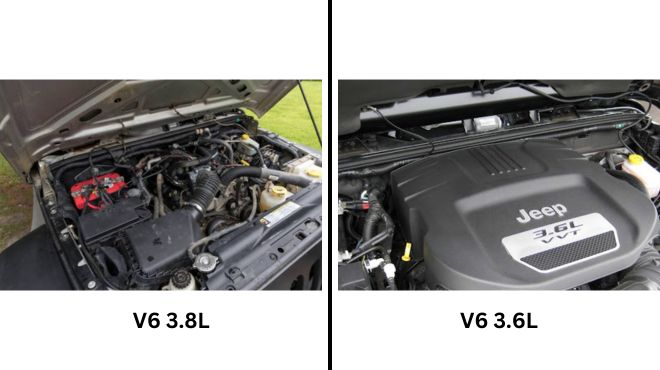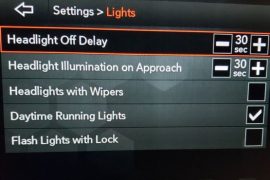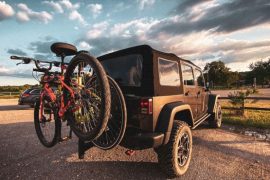When shopping for a Jeep, one key decision is between the 3.8L V6 or the more powerful 3.6L V6 engine. The 3.8 makes a reasonable 202 horsepower while the 3.6 cranks out a meaty 285. Towing capacity goes up from 3,500 pounds with the 3.8 to 4,000 with the 3.6. But you’ll pay more upfront and long-term for the 3.6’s extra capability.
Ultimately it depends on what you prioritize – if reliability and affordability matter most, the proven 3.8L is probably the best fit. However, if you want maximum muscle for off-roading or towing, the advantages of the modern 3.6L may justify the added costs. Evaluate your needs and budget to pick the Jeep engine that aligns with your priorities.

| Feature | 3.8L | 3.6L |
|---|---|---|
| Engine Type | SOHC V6 | DOHC V6 |
| Displacement | 3.8L (231 cu in) | 3.6L (218 cu in) |
| Horsepower | 202-245 hp | 285 hp |
| Torque | 237-280 lb-ft | 260 lb-ft |
| Fuel Economy (City/Highway) | 15/19 mpg | 16/21 mpg |
| Transmission Options | 4-speed automatic, 6-speed automatic | 5-speed automatic, 8-speed automatic |
| Available Vehicles | Wrangler JK | Wrangler JK, Wrangler JL, Gladiator, Grand Cherokee |
| Years Offered | 2007-2011 | 2012-Present |
| Towing Capacity | 2,000-3,500 lbs (depending on configuration) | 3,500 lbs (standard on most vehicles) |
| Reliability | Mixed reports; some head gasket issues | Generally reliable |
| Performance | Adequate, sluggish with larger tires | Strong, smooth acceleration |
| Fuel Efficiency | Lower than 3.6L | More fuel-efficient than 3.8L |
| Technology | Less advanced, with features like direct injection | More advanced and variable valve timing |
| Cost | Less expensive to acquire | Generally more expensive than 3.8L |
In this post, we’ll compare key differences head-to-head so you can weigh the pros and cons. So you can make an informed decision between the 3.8L and 3.6L.
| Model Year | Engine | Key Features |
|---|---|---|
| 1991-2006 | PowerTech 3.8L V6 | OHV, cast iron block, single-barrel throttle body |
| 2007-2011 | Chrysler 3.8L V6 | SOHC, aluminum block, multi-stage intake manifold |
| 2012-Present | Pentastar 3.6L V6 | DOHC, aluminum block, direct injection |
Jeep 3.8L V6 Engine Overview
Debuted in 1987 With 20+ Years of Service
The 3.8L V6 was first dropped into Jeeps back in 1987 and stuck around for over two decades of faithful service. That’s right – if you climbed into a Jeep made between the late 80s and 2010, chances are it had this motor under the hood. Talk about a tried and true legacy!
Horsepower and Torque
This engine churns out 202 eager horsepower along with 237 lb-ft of torque. Not huge power, but enough gusto for most Jeep adventures. The 3.8L V6 takes drivers from 0 to 60 mph in a reasonable 8.5 seconds – not lighting fast but far from a lagger.
Simple and Straightforward Design
One of the biggest perks of the 3.8L is its simple, straightforward design. This is an old-school, uncomplicated engine that’s easier for the average owner to maintain themselves or find an affordable mechanic to work on. Without lots of fancy tech and complex parts, repairs and upkeep on the 3.8L tend to be cheaper over the long run.
So if you want a proven Jeep powertrain with decades of reliability behind it, the 3.8L V6 is a solid choice. Let’s now see how it stacks up against the new kid on the block – the 3.6L upgrade.
Jeep 3.6L V6 Engine Overview
Newer engine introduced in 2012
If you’ve got a newer Jeep built in the last decade or so, chances are there’s a 3.6L V6 engine lurking under the hood. This powertrain debuted in 2012 as a modern upgrade over the aging 3.8L.
More powerful – 285 horsepower and 260 lb-ft torque
The 3.6L boasts a meaty 285 horsepower and 260 lb-ft of torque – big gains over its predecessor that you’ll notice whenever you stomp on the gas. We’re talking 0 to 60 mph in just 6.7 seconds in some Jeep models – now that’s move-out authority!
Modern Technology
Beyond raw muscle, the 3.6L also sports some fancy tech that helps optimize performance and efficiency. The engine has dual overhead cams (DOHC) to precisely control valve timing along with variable valve timing (VVT). This coordinate the airflow and combustion at different RPMs for max power when you need it and fuel-sipping cruising when you don’t.
The 3.6L is the obvious choice if you want the newest Jeep with the most muscle and tech under the hood. But you’ll pay more upfront and potentially higher long-term ownership costs.
Power and Performance Comparison
When it comes to sheer grunt, the 3.6L V6 clearly outmuscles the old 3.8L. With 80+ more horsepower and 20+ more pound-feet of torque, the 3.6L leaves its predecessor in the dust.
You’ll notice the added oomph not just from a stop but also when passing or merging on the highway. The 3.6L makes ascending steep mountain roads or cruising with a trailer feel much less labored. This extra power gives you more confidence to handle challenging driving conditions.
The 3.6L also edges out the 3.8L when it comes to fuel efficiency, with EPA ratings of 16 mpg city/21 highway versus 15/19 for the 3.8L. So you get improved performance AND better gas mileage out of the deal.
When taking your Jeep off-road, the 3.6L’s surplus of horsepower lets it scamper up inclines, crawl over rocks and power through mud better than the workhorse 3.8L engine. You’ll have more capability on the tough stuff.
You can also haul and tow more weight with the 3.6L. It boasts a max tow rating of 4,000 pounds, while the 3.8L tops out at 3,500 pounds.
So if you want maximum muscle for tackling trails or getting work done, the 3.6L V6 has a clear performance advantage over the stalwart 3.8L. But there are some other trade-offs to consider.
Off-Road Capabilities
One of the main reasons people buy Jeeps is to venture off the beaten path to experience epic trails and rugged terrain. Both the 3.8L and 3.6L engines can capably handle off-road driving thanks to available four-wheel drive on Jeep models.
4WD allows you to take on mud, snow, steep hills and rocky sections with improved grip and control compared to regular two-wheel drive SUVs. By sending power to all four wheels, Jeeps can better claw their way through tough conditions.
While both engines offer 4WD, the extra horsepower and torque of the 3.6L give it an edge in extreme off-road driving. The added grunt lets you power up steeper climbs, squash bigger rocks under the tires, and muscle through deep ruts or mud better than the 3.8L can.
So the 3.6L’s abundant power translates to expanded off-road capability. But there are some other factors to weigh when deciding between these two motors.
Cost Considerations
When shopping for a new Jeep, the engine you choose will impact what you pay upfront and down the road. There are significant cost differences between the 3.8L and 3.6L that savvy buyers will want to consider.
In general, the 3.8L V6 is the more affordable option both for purchase price and long-term ownership costs. Since it’s an older, less complex design that’s been around for ages, repairs and maintenance on the 3.8L tend to be cheaper compared to the newer 3.6L. Replacement parts are also more widely available and economical.
With the 3.6L, you’re paying for the extra performance and technology, so expect to see a higher price tag at the dealership. And because it’s a more modern, sophisticated engine, repair costs are typically more expensive when things need fixed or replaced.
If getting the lowest upfront price and ongoing ownership costs are priorities for you, the venerable 3.8L V6 is less costly over the life of your Jeep. But for some buyers, the increased capability and driving experience of the 3.6L are worth the premium.
Also see – Jeep 6 Speed Manual Transmission Problems: Causes and Fixes
Pros and Cons of Each Engine
3.8L V6 Pros:
- Proven reliable and durable after 20+ years of use
- More simple design is easier for owners to maintain
- Lower purchase price and affordable repair costs
3.8L V6 Cons:
- Noticeably less horsepower and torque than 3.6L
- Max tow rating of only 3,500 pounds
- Worse fuel economy ratings
3.6L V6 Pros:
- Significantly more horsepower and torque
- Faster acceleration and towing capacity of 4,000 lbs
- Upgraded transmission and tech improves performance
- Better EPA estimated MPG
3.6L V6 Cons:
- More expensive initial purchase price
- Potentially pricier long-term maintenance and repairs
- Complex design could mean more issues down the road
Driving Experience
When you hop into the driver’s seat, the extra power of the 3.6L V6 delivers a noticeably smoother, livelier driving experience compared to the 3.8L. The huge bump in horsepower makes acceleration quicker and passing ability stronger with the new engine.
Part of the performance boost comes from the 3.6L’s upgraded transmission which helps put all that muscle to the pavement more efficiently. Expect a more responsive, agile feel behind the wheel.
Model Year Differences
The 3.6L V6 first became available in 2012 model year Jeeps. So if having the latest Jeep is important to you, the 3.6L is your only option in recent years.
The 3.8L engine was phased out after 2010, though many older Jeeps are still on the road using this durable powerplant. But for the newest tech and design along with the extra horsepower, you’ll want to look for a 2012 or newer model equipped with the 3.6L.
This gives you a taste of how the driving experience and model year availability differ between these two top Jeep engines.
Which Jeep Engine is Right for You?
When it comes to choosing between the 3.8L versus 3.6L V6 engines, it mainly comes down to priorities.
The 3.8L is tried and true after 20+ years of service. Its affordable price and simple design make it a good choice if reliability and cost savings are most important to you.
But if you want maximum muscle, acceleration and towing capability along with the latest tech, the 3.6L clearly outperforms. Just be prepared to pay more upfront and potentially down the road.
Take time to honestly assess your needs and budget. How much capability do you really require, and how much are you willing to spend initially and on maintenance? This will steer you towards either the economical 3.8L or powerful 3.6L.
For most daily driving and light off-roading, the 3.8L should meet your needs just fine. But driving enthusiasts who love performance will find the 3.6L worth stretching the budget.
Either way, choosing between two proven Jeep engines is a win-win. Both offer ample power to handle adventures on pavement or trail. Weigh the key differences and you’ll pick the perfect V6 for your new Jeep.
Also Read:



